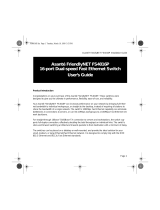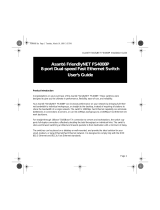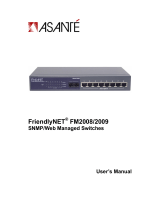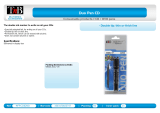Page is loading ...

MacCon Family
Ethernet Network Cards
for the Macintosh
Installation Guide
ASANTÉ
MacConi Front Cover Page 1 Friday, August 23, 1996 10:16 AM

Asanté MacCon
Adapter Family
Installation Guide
Asanté Technologies, Inc.
821 Fox Lane
San Jose, CA 95131
October 1994
Part Number 06-00141-00 Rev. B
Printed in USA

Copyright Notice
Copyright 1994 by Asanté Technologies, Inc.
All rights reserved. No part of this manual, or any associated artwork, software,
product design or design concept, may be copied, reproduced or stored, in whole or
in part, in any form or by any means mechanical, electronic, optical, photocopying,
recording or otherwise, including translation to another language or format, without
the express written consent of Asanté Technologies, Inc.
EtherTalk and Installer are copyrighted programs of Apple Computer, Inc., and are
licensed to Asanté Technologies, Inc. to distribute for use only in combination with
Asanté Ethernet interface products. EtherTalk shall not be copied onto another disk
or diskette (except for archive purposes) or into memory unless as part of the
operation of Asanté Ethernet interface card products.
Trademarks
Asanté Technologies, MacCon-i, MacCon+, MacCon3, FriendlyNet, EN/SC and the
Connectivity Solution are trademarks of Asanté Technologies, Inc.
Apple, AppleTalk, EtherTalk, AppleShare, and Macintosh are registered trademarks of
Apple Computer, Inc.
Ethernet is a registered trademark of the Xerox Corporation, Inc.
FCC Information
This equipment is classified as a Class A computing device. Class A devices may be
used only in commercial, business, or industrial environments.
This equipment generates, uses and can radiate radio frequency energy. If this
equipment is not insulated properly in strict accordance with the instructions in this
manual, then it may cause interference in this electronic environment. This
equipment has been tested and found to comply with the limits for a Class A
computing device pursuant to Subpart J of Part 15 of FCC Rules, which are designed
to provide reasonable protection against radio frequency interference when operated
in a commercial environment.
Operation of this equipment in a residential area is likely to cause interference, in
which case, the user at his own risk and expense will be required to correct the
interference.
Asanté Warranty
This Asanté MacCon Ethernet interface card product has a limited lifetime warranty
which applies to the original purchaser of the product. Asanté Technologies, Inc.
warrants that this product will be free from defects in title, materials and
manufacturing workmanship. If the MacCon Ethernet interface card product is found
to be defective, then, as your sole remedy and as the manufacturer’s only obligation,
Asanté Technologies, Inc. will repair or replace the product provided that (1) you call
Asanté Technologies, Inc. for a Returned Merchandise Authorization (RMA) number,
that (2) you clearly write this RMA number on the outside of the package, and that
(3) you return it, postage prepaid, during the warranty period. This warranty is
exclusive and is limited to Asanté MacCon Ethernet network interface card products.
This limited lifetime warranty shall not apply to Asanté MacCon Ethernet interface
card products that have been subjected to abuse, misuse, abnormal electrical or
environmental conditions, or any condition other than what can be considered
normal use.
∆
Note: The warranty card must be filed with Asanté Technologies, Inc. within
30 days after date of purchase.

Asanté Warranty Disclaimer
Asanté Technologies, Inc. makes no other warranties, express, implied or otherwise,
regarding Asanté Ethernet interface card products, and specifically disclaims any
warranty for merchantability or fitness for a particular purpose.
The exclusion of implied warranties is not permitted in some States and the
exclusions specified herein may not apply to you. This warranty provides you with
specific legal rights. There may be other rights that you have which vary from State
to State.
Apple Warranty Disclaimer
The following disclaimer is required by Apple Computer, Inc. It applies only to the
EtherTalk computer software from Apple enclosed with Asanté Ethernet interface
products. All Asanté software is covered by Asanté’s limited warranty.
APPLE COMPUTER, INC. (“APPLE”) MAKES NO WARRANTIES, EXPRESS OR IMPLIED,
INCLUDING WITHOUT LIMITATION THE IMPLIED WARRANTIES OF
MERCHANTABILITY AND FITNESS FOR USE FOR A PARTICULAR PURPOSE,
REGARDING THE APPLE SOFTWARE. APPLE DOES NOT WARRANT, GUARANTEE OR
MAKE ANY REPRESENTATIONS REGARDING THE USE OR THE RESULTS OF THE USE
OF THE APPLE SOFTWARE IN TERMS OF ITS CORRECTNESS, ACCURACY,
RELIABILITY, CURRENTNESS OR OTHERWISE. THE ENTIRE RISK AS TO THE RESULTS
AND PERFORMANCE OF THE APPLE SOFTWARE IS ASSUMED BY YOU. THE
EXCLUSION OF WARRANTIES IS NOT PERMITTED BY SOME STATES. THE ABOVE
EXCLUSION MAY NOT APPLY TO YOU.
IN NO EVENT WILL APPLE, ITS DIRECTORS, OFFICERS, EMPLOYEES OR AGENTS BE
LIABLE TO YOU FOR ANY CONSEQUENTIAL, INCIDENTAL OR INDIRECT DAMAGES
(INCLUDING DAMAGES FOR LOSS OF BUSINESS PROFITS, BUSINESS
INTERRUPTION, LOSS OF BUSINESS INFORMATION, AND THE LIKE) ARISING OUT
OF THE USE OR THE INABILITY TO USE THE APPLE SOFTWARE EVEN IF APPLE HAD
BEEN ADVISED OF THE POSSIBILITY OF SUCH DAMAGES. BECAUSE SOME STATES
DO NOT ALLOW THE EXCLUSION OR LIMITATION OF LIABILITY FOR
CONSEQUENTIAL OR INCIDENTAL DAMAGES, THE ABOVE MAY NOT APPLY TO YOU.
APPLE’S LIABILITY TO YOU FOR ACTUAL DAMAGES FROM ANY CAUSE
WHATSOEVER, AND REGARDLESS OF THE FORM OF THE ACTION (WHETHER IN
CONTRACT, TORT (INCLUDING NEGLIGENCE), PRODUCT LIABILITY OR
OTHERWISE) WILL BE LIMITED TO $50.
Limitation of Liability
The liability of Asante Technologies, Inc. arising from this warranty and sale shall be
limited to a refund of the purchase price. In no event shall Asante Technologies, Inc.
be liable for costs of procurement of substitute products or services, or for any lost
profits, or for any consequential, incidental, direct or indirect damages, however
caused and on any theory of liability, arising from this warranty and sale. These
limitations shall apply notwithstanding any failure of essential purpose of any remedy.

Asking for assistance
To contact Asanté Technical Support:
Technical support hours
6:00 AM to 6:00 PM Pacific Standard Time USA, Monday–Friday
Tell us what you think
Asanté Technologies is interested in your comments/suggestions
about our manuals. If you take the time to make suggestions, we’ll
consider your suggestions for new manual releases.
Please read through this manual and think about these questions:
• What do you like best about this manual?
• What do you think is the least valuable or weakest part of
this manual?
• What is the most needed improvement you would make to
this manual?
Fax your comments and suggestions to:
Asanté Technical Publications at (408) 894-0363
or
E-mail them through Internet:
a Please request catalog of contents.
b Download INDEX.TXT file for catalog of contents.
c When sending email, please include your full name, US mailing address,
phone number, product name and a problem description.
Telephone
(800) 622-7464
(408) 435-0706
Fax
(408) 432-6018
Fax-Back
a
(800) 741-8607
(408) 954-8607
Bulletin Board Service (BBS)
b
(408) 432-1416
ARA BBS
b
(guest log in)
(408) 894-0765
Applelink mail
c
/BBS
b
ASANTE.TECH
FTP Archive
b
ftp.asante.com
Internet mail
c

i
Table of Contents
Asking for assistance i
Technical support hours i
Tell us what you think i
Introducing the
Asanté MacCon Cards 1-1
Summary of MacCon Card Features 1-2
The Math Co-processor Option 1-2
Asanté EtherTalk Installer Software 1-2
Installing Asanté MacCon Cards 2-1
Preparing for the Installation 2-1
Checking the Requirements 2-1
Observing the Safety Rules 2-2
The MacCon NuBus Card 2-3
Installing the MacCon NuBus Card 2-4
Installing the MacCon 610 Card 2-6
Installing a MacCon LC Card 2-9
Installing a MacCon LC Card in a Color Classic 2-10
Installing the MacCon3 IIsi and MacCon 30i Cards 2-13
Setting the Cable Type on the Daughter Card 2-13
Video Options 2-14
Setting the Slot Address for Two Cards 2-14
Installing the Math Co-processor 2-15
Installing in a Macintosh IIsi 2-16
Installing a MacCon3 IIsi and a Radius Pivot IIsi 2-18
Installing a MacCon Card in a Macintosh SE/30 2-19
Installing a MacCon+ SE Card in a Macintosh SE 2-21
Setting the Cable Type on the Daughter Card 2-21
Connecting the Macintosh to the Network 2-24
With 10BaseT cabling 2-24
Installing the EtherTalk Software 2-25
Two Types of Software Installations 2-25
About EtherTalk Phase 1 and Phase 2 2-26
Installation Procedures 2-26
Accessing Network Services 2-28
Asanté SNMP MacAgent 3-1
Introduction 3-1
TCP/IP Protocol Stack 3-1
IP Addressing 3-1
Requirements 3-2
AsantéView In-Band Network Management Software 3-2

ii
Accessing Asanté MacAgent MIB 3-2
Asanté SNMP MacAgent and the TCP/IP Protocol 3-2
Asanté SNMP MacAgent as a Network Diagnostic Tool 3-3
Installing SNMP MacAgent 3-3
Configuring MacTCP 3-4
Configuring SNMP MacAgent 3-5
Asanté SNMP Configuration Parameters 3-6
AsantéView Network Management Station 3-7
Other Network Management Software 3-8
Using TroubleShooter and ADLS Diagnostic Software 4-1
Running TroubleShooter Diagnostics 4-1
Changing from EtherTalk to LocalTalk 4-1
Starting TroubleShooter Diagnostics 4-2
Running other TroubleShooter tests 4-3
Running the Loopback test 4-4
Running the Bandwidth Utilization test 4-4
If a test fails 4-6
Quitting TroubleShooter and restarting network services 4-7
Running ADLS 4-7
Troubleshooting 5-1
Checking the Basics 5-1
Do You Have the Current Asanté Driver Software? 5-1
Running TroubleShooter 5-2
Other Tips 5-2
Installing the Math Co-processor Option 5-2
Macintosh IIsi with a PDS Slot 5-2
Questions and Answers to Common Problems 5-3
Technical Specifications A-1
MacCon Specifications A-1
Ethernet Address A-2
MacCon LEDs A-3
Ethernet Specifications A-3
Connector Pin-outs A-4
AAUI Connector A-4
RJ-45 Connector A-6
Index i

iii
List of Figures
Figure 2-1 Selecting AUI, MacCon NuBus card 2-3
Figure 2-2 Disabling Link Integrity, MacCon-i NuBus card 2-4
Figure 2-3 Installing a MacCon 3 NuBus card 2-5
Figure 2-4 Installing MacCon NuBus card, Apple Centris 610 2-6
Figure 2-5 Selecting the AUI port, MacCon 610 card 2-7
Figure 2-6 Disabling link integrity, MacCon 610 card 2-7
Figure 2-7 The MacCon 610 card plugged into the expansion slot on the
motherboard 2-8
Figure 2-8 Disabling link integrity, LCIII card 2-9
Figure 2-9 The MacCon LC card plugged into the expansion slot on the
motherboard 2-10
Figure 2-10 The rear panel removed on the Color Classic 2-11
Figure 2-11 Installing the MacCon LC in the expansion slot in the Color
Classic 2-12
Figure 2-12 The MacCon3 IIsi controller card and daughter card installed
in a Macintosh IIsi 2-15
Figure 2-13 Removing the MacCon3 IIsi daughter card 2-17
Figure 2-14 Installing a MacCon3 IIsi card with a Radius card 2-17
Figure 2-15 Installing a MacCon+ 30i card in a Macintosh SE/30 2-19
Figure 2-16 Installing the MacCon SE daughter controller card and
daughter card 2-22
Figure 2-17 The Easy Install dialog box 2-27
Figure 2-18 Network control panel 2-28
Figure 2-19 An example of a user’s Chooser dialog box 2-29

Chapter 2
1-1
Chapter 1
Introducing the
Asanté MacCon Cards
Thank you for purchasing a MacCon network interface card from
Asanté Technologies. Asanté’s MacCon cards enable you to connect
any Macintosh with an available expansion slot to a high speed Ether-
net network.
The MacCon Family consists of the
MacCon
and
MacCon-i
series. The
MacCon-i series, designed with advanced integration technology, is
available only for Macintosh systems with NuBus and LC PDS expan-
sion slots.
The MacCon cards are described in the table below.
10BaseT and Thick Thin and Thick
10BaseT, Thin,
and Thick
NuBus Macs
MacCon-i NB-10T
99-00198-01
MacCon+ IIET64
99-00102-10
MacCon-i NB-TN
99-00197-01
MacCon+ IIET64
99-00101-02
MacCon3 NB
99-00301-02
MacCon-i NB-3
99-00196-01
Centris 610 PDS,
Quadra 610, and
Centris 660 AV
MacCon+ 610ET
99-00162-01
MacCon+ 610E
99-00161-01
MacCon3 610
99-00160-01
Mac IIsi and
Mac SE/30
MacCon+ 30iET64
99-00203-03
MacCon+ 30iE64
99-00204-02
MacCon3 IIsi
99-00302-02
Mac LC PDS
MacCon-i LC-10T
(10BaseT only)
99-00219-01
MacCon LC10TIII
(10BaseT only)
99-00093-01
MacCon-i LC-TN
(Thin only)
99-00218-01
MacCon LCTNIII
(Thin only)
99-00089-01
MacCon-i LC-TN/10T
(10BaseT and Thin)
99-00217-01
MacCon+ LCIII
(10BaseT and Thin)
99-00089-01
Mac SE
MacCon+ SEET
99-00300-03
MacCon+ SEE
99-00300-02
MacCon3 for SE
99-00302-04
MacConi ch 1 Intro Page 1 Friday, August 23, 1996 10:08 AM

1-2 Introducing the Asanté MacCon Cards
The term
MacCon cards
is used in this manual to refer to all cards in
the MacCon Family. When text applies only to a specific card, it is
identified by its name.
Summary of MacCon Card Features
Asanté MacCon cards offer the following features:
❏
Support for all Macintosh computers with expansion slots
❏
Compatibility with Apple® System 7, and EtherTalk Phase 1™
and Phase 2 ™
❏
Compliance with the IEEE 802.3 standard for 10BaseT
(Twisted-Pair), Thin, and Thick Ethernet
❏
Compatible with the following software environments: Apple-
Share™, Novell NetWare™ for Macintosh, 3Com 3+Open™,
3Com 3+Share™, Sitka TOPS™, DEC Pathworks™, A/UX, and
other popular network software
❏
Supports the following protocols: AppleTalk, TCP/IP, and
DecNet
❏
High performance true 32-bit internal data transfers with
tuned drivers for optimal performance
❏
Diagnostic software for help in identifying problems
❏
A PDS pass-through slot and a removable AUI port on the
MacCon3 IIsi cards allowing you to install more than one PDS
card in a Macintosh IIsi
❏
A socket for an additional Motorola 68882 math co-processor
on the MacCon3 IIsi, 30i and LC cards
The Math Co-processor Option
An optional socket for a math co-processor is provided with the fol-
lowing MacCon cards: MacCon LC, MacCon IIsi, MacCon 30i. This
socket accepts the Motorola 68882 PLCC Math Co-Processor™. For
the correct math co-processor chip and installation procedure, check
your Macintosh documentation.
Asanté EtherTalk Installer Software
An Asanté EtherTalk Installer diskette is included with each Asanté
MacCon card. The diskette contains Asanté’s EtherTalk driver,
Asanté Network and Diagnostic Utility software and Apple network-
ing software. Asanté’s EtherTalk device driver enables AppleTalk to
communicate with the Ethernet interface card.
MacConi ch 1 Intro Page 2 Friday, August 23, 1996 10:08 AM

Chapter 2
2-1
Chapter 2
Installing Asanté MacCon Cards
This chapter provides step-by-step instructions for installing Asanté
MacCon Ethernet network interface cards and EtherTalk software.
To install an Asanté MacCon Ethernet card, you will perform the fol-
lowing operations:
❏
Prepare for the installation
❏
Install the MacCon card
❏
Connect the Macintosh to the network cable
❏
Terminate the cable where applicable
❏
Install the EtherTalk software
Preparing for the Installation
Before you open the anti-static bag containing the card, you must
prepare for the installation as described below.
Make sure you meet all the requirements and are aware of the safety
rules.
Checking the Requirements
Before you open the anti-static bag containing the Asanté MacCon
card, make sure you have the following:
❏
The required software:
Apple system software 6.0.8 or higher
A network operating system or a compatible system and appli-
cation software to run the network, provided by Apple or a
third-party vendor.
❏
The EtherTalk Installer diskette provided by Asanté.

2-2 Installing Asanté MacCon Cards
❏
The appropriate Asanté card and Ethernet hardware for your
cabling:
Refer to Appendix B for detailed Ethernet specifications.
Observing the Safety Rules
Do not remove the network interface card from its anti-static bag
until you are ready to insert it into the expansion slot. The interface
cards are sensitive to static electricity and must be handled very care-
fully. Improper handling or installation can result in damage to your
card and/or your Macintosh.
Any damage you may cause to the computer or card will not be cov-
ered by the limited warranty.
Observe the following safety precautions during the installation:
❏
Consult your network administrator about the card installa-
tion before connecting to the network..
❏
Turn off the Macintosh and all peripherals connected to it.
❏
If you need to lay a Macintosh flat on its face, use an anti-
static mat.
❏
When installing the MacCon+ SE or SE/30 card, be extremely
careful not to touch any part of the exposed circuitry. Some
circuit components retain a high voltage charge long after the
power is disconnected.
a. Asanté offers a full range of intelligent and non-intelligent 10BaseT-com-
pliant hubs.
Cabling Requires Comments
10BaseT Hub and RJ-45
connector
10BaseT-compliant hub
required
a
Thin Pair of 50-ohm
terminator plugs
and BNC connector
One plug for each end of
thin Ethernet cable
Thick External media
adapter and DB-15
(AUI) connector
Connects Macintosh to a
drop cable. One for each
Macintosh connected to
the network

Installing Asanté MacCon Cards 2-3
❏
Ground yourself by using an anti-static wrist strap. Attach it to
the chassis once you have opened the Macintosh, but before
handling the Asanté card or touching any component inside
the system.
❏
Handle the Asanté card by the edges and avoid touching the
connectors and chips.
❏
Keep the Asanté card in the anti-static bag until you are ready
to install it in the Macintosh.
The MacCon NuBus Card
If your Macintosh accepts NuBus expansion cards, you can use the
MacCon NuBus network interface card to connect the Macintosh to
an Ethernet network.
You install a MacCon NuBus card into an unused Nubus expansion
slot on the motherboard.
Refer to your computer’s User Guide for illustrated instructions on
how to open your Macintosh computer.
MacCon NuBus Card
∆
Note: If you are using
Thick
Ethernet (10Base5) cabling
and your network does not have 10Base5-compliant
Ethernet transceivers, you may need to force the card to
select the AUI port by setting the JP1 jumper ON as
shown in Figure 2-1.
Figure 2-1
Selecting AUI, MacCon NuBus card
JP1
ON
to force AUI port
JP1 jumper
port autosense
(default)

2-4 Installing Asanté MacCon Cards
MacCon-i NuBus Card
∆
Note: If you wish to disable link integrity, use the JP1
jumper on the MacCon NuBus card, as shown in Figure 2-
2. (For example, hubs made before the 10BaseT specifica-
tions were published do not support link integrity.)
Figure 2-2
Disabling Link Integrity, MacCon-i NuBus card
Installing the MacCon NuBus Card
1
Power down the Macintosh. Disconnect and remove the
power cable.
2
Open the Macintosh.
3
Remove the access port cover. Make sure you are ground-
ed: check that your anti-static wrist strap is properly at-
tached to your wrist and to the Macintosh chassis.
4
Plug the MacCon card into the NuBus expansion slot on
the motherboard:
— With the card’s Ethernet connectors facing the expan-
sion slot access port, carefully line up the card’s edge
connector with the expansion slot (see Figure 2-3).
JP1
Link integrity disabled
JP1 jumper
Link integrity enabled
(default)

Installing Asanté MacCon Cards 2-5
Figure 2-3
Installing a MacCon 3 NuBus card
— Gently press on the card until the connector is fully seat-
ed and the card is flush with the card holders at both
ends.
With a Centris 610
If you are installing a MacCon NuBus card in an Apple
Centris 610, you need to use the Apple Centris 610 NuBus
Adapter, which is not included with the MacCon NuBus card.
The Apple Centris NuBus Adapter part number is M1402LL/A.
— Slide the MacCon NuBus card into the Centris 610 Nu-
Bus Adapter.
— Plug the adapter into the NuBus expansion slot as shown
in Figure 2-4 on page 2-6.
5
Close the case.
6
Connect the Macintosh to the network as described in
"Connecting the Macintosh to the Network" on page 2-24.

2-6 Installing Asanté MacCon Cards
Figure 2-4
Installing MacCon NuBus card, Apple Centris 610
Installing the MacCon 610 Card
If you have a Macintosh Centris 610, you can use a MacCon 610 card
to connect to the Ethernet. Each card consists of two parts:
❏
The larger
controller
card, which plugs into the expansion
slot in the Macintosh.
❏
The smaller
daughter
card, which is mounted on the rear
access port to enable a connection to the Ethernet cable.
You connect the two cards before installing them.
To install the MacCon3 610, MacCon+ 610E, or MacCon+ 610ET
card in a Macintosh Centris 610, perform the following steps:
1
Set jumpers if needed (see the next two Notes and
Figures 2-5 and 2-6).
Motherboard
Expansion slot
Apple Centris 610
NuBus adapter
(M1402LL/A
)

Installing Asanté MacCon Cards 2-7
∆
Note: In some cases with Thick Ethernet (10Base5) cabling
when your network does not have 10Base5-compliant Ethernet
transceivers, you may need to force the NuBus card to select
the AUI port by setting the JP1 jumper ON as shown in
Figure 2-5.

2-8 Installing Asanté MacCon Cards
3
Power down the Macintosh. Disconnect and remove the
power cable.
4
Open the Macintosh and remove the access port cover.
5
Make sure you are grounded: check that your anti-static
wrist strap is properly attached to your wrist and to the
Macintosh chassis.
6
Plug the controller card (with daughter card attached) in-
to the expansion slot on the motherboard (see Figure 2-7).
Figure 2-7
The MacCon 610 card plugged into the expan-
sion slot on the motherboard
7
Align the chassis bracket with the access port on the back
cover.
8
Secure the daughter card to the chassis using the two
screws.
9
Close the case.
10
Connect the Macintosh to the network as described in
"Connecting the Macintosh to the Network" on page 2-24.
Motherboard
Expansion slot
MacCon Centris 610
controller card
MacCon Centris 610
daughter card

Installing Asanté MacCon Cards 2-9
Installing a MacCon LC Card
If you have a Macintosh LC, LCII, or Color Classic computer, use the
MacCon LCIII or MacCon-i LC card to connect the Macintosh to the
Ethernet.
Caution
Only the LC and LCII computers can accept FPUs on the LC card. If
your Macintosh already has a math co-processor (or FPU), do not
install the Asanté math co-processor option with the card.
Refer to your Macintosh User’s Guide for illustrated instructions for
opening your computer.
∆
Note: LCIII card
—You can disable link integrity on the Mac-
Con LCIII card by setting the JP2 jumper as indicated in Figure
2-8. (For example, hubs made before the 10BaseT specifica-
tions were published do not support link integrity.)
Figure 2-8
Disabling link integrity, LCIII card
To install the MacCon LC card into the expansion slot on the moth-
erboard, perform the following steps:
1
Power down the Macintosh. Disconnect and remove the
power cable.
2
Open the Macintosh.
3
Make sure you are grounded: check that your anti-static
wrist strap is properly attached to your wrist and to the
Macintosh chassis.
4
Insert the card into the expansion slot.
!
JP2
disabled
enabled
JP2–link integrity

2-10 Installing Asanté MacCon Cards
With the card’s components facing down, carefully angle its
external connector through the Ethernet port, then line up
its edge connector with the motherboard expansion slot.
5
Gently press on the card until the connector is fully seated
(see Figure 2-9).
Figure 2-9
The MacCon LC card plugged into the expan-
sion slot on the motherboard
6
Connect the Macintosh to the network as described in
"Connecting the Macintosh to the Network" on page 2-24.
Installing a MacCon LC Card in a Color Classic
1
Power down the Macintosh Color Classic. Disconnect and
remove the power cable.
MacCon+ LC card
Motherboard
Expansion slot
/










